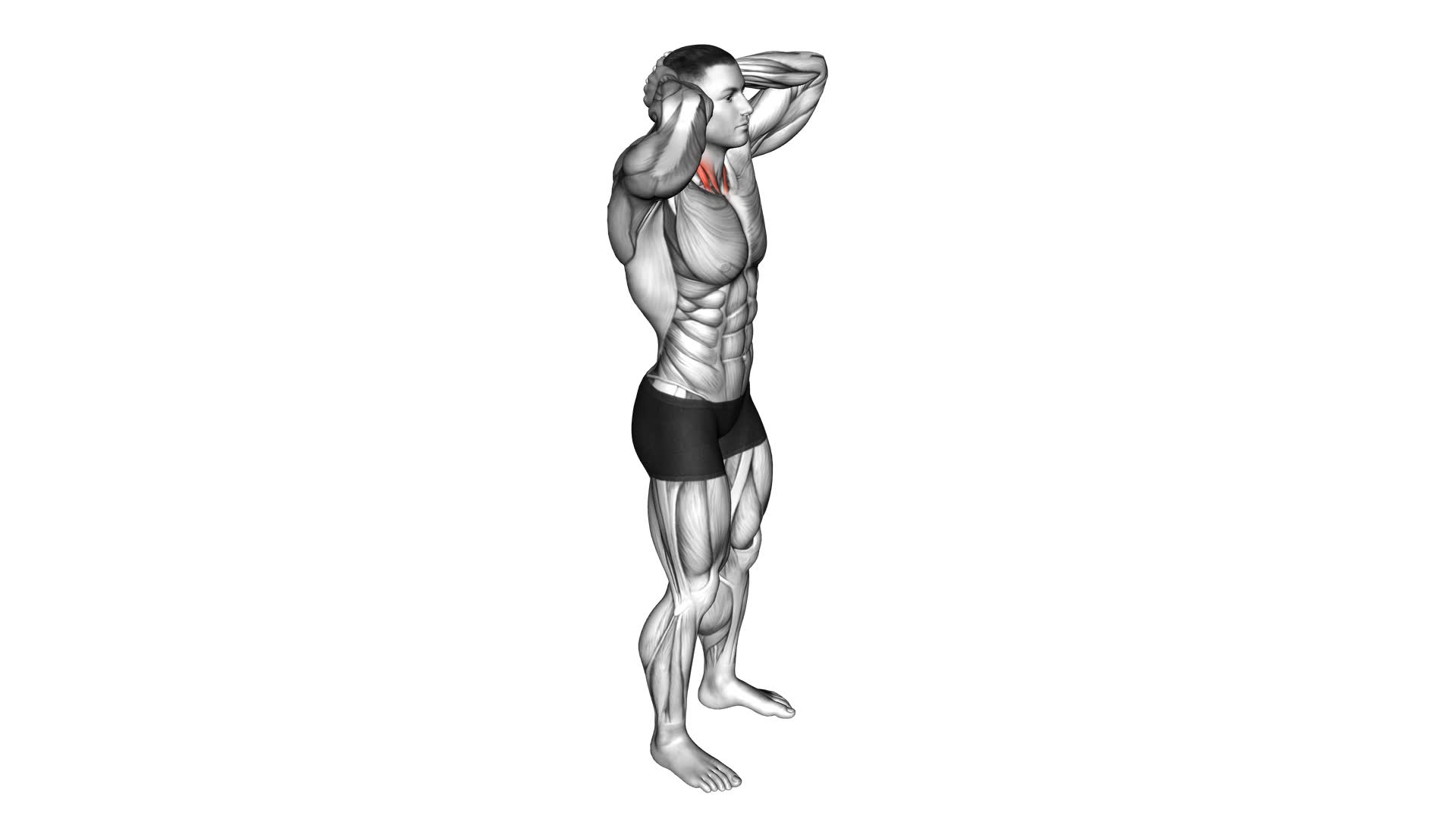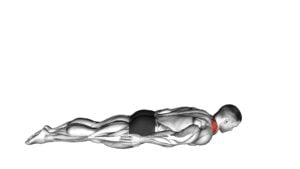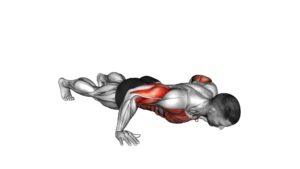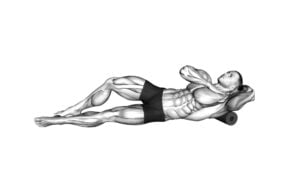Posterior Neck Isometric – Video Exercise Guide & Tips

Are you looking for a quick and effective way to strengthen your neck muscles? Look no further than the posterior neck isometric exercise!
Watch This Exercise Video
In this video exercise guide, we'll show you the proper form and technique, as well as common mistakes to avoid.
Plus, we'll provide variations and progressions to keep challenging yourself.
Don't miss out on this opportunity to incorporate the posterior neck isometric exercise into your fitness routine.
Let's get started!
Key Takeaways
- The posterior neck isometric exercise strengthens the muscles in the neck.
- It helps maintain good posture and reduces the risk of neck pain and stiffness.
- The exercise stabilizes the muscles in the neck and prevents injuries during rapid head movements or impact.
- Proper neck alignment is important for maximizing exercise effectiveness and preventing injury.
Benefits of the Posterior Neck Isometric Exercise
To understand the benefits of the posterior neck isometric exercise, it's important for you to know that it helps strengthen and stabilize the muscles in your neck. The neck is a crucial part of the body that supports the head and allows for its movement. By engaging in the posterior neck isometric exercise, you can reap a multitude of benefits.
Firstly, this exercise helps to strengthen the muscles in your neck. The isometric nature of the exercise means that you're contracting your muscles without any movement. This sustained contraction works the muscles in your neck, making them stronger over time. Strong neck muscles are important for maintaining good posture and reducing the risk of neck pain and stiffness.
Additionally, the posterior neck isometric exercise helps to stabilize the muscles in your neck. This stability is essential for preventing injuries, especially during activities that involve rapid head movements or impact. By strengthening and stabilizing the muscles in your neck, you can improve your overall neck function and reduce the risk of strains and sprains.
Equipment Needed for the Exercise
You will need some equipment for the posterior neck isometric exercise. Here are three items that will help you perform this exercise effectively:
- Resistance Band: A resistance band is a versatile piece of equipment that will provide the necessary resistance for your neck exercises. It allows you to adjust the intensity of the exercise by choosing a band with the appropriate tension level.
- Stability Ball: A stability ball can be used to support your upper body during the exercise. By lying face down on the ball, you can stabilize your body while targeting the muscles in your posterior neck.
- Exercise Mat: An exercise mat will provide cushioning and support for your body during the exercise. It's important to have a comfortable and non-slip surface to lie on while performing the neck exercises.
These three items will help you modify the exercise to suit your fitness level and goals. With the resistance band, you can increase or decrease the intensity of the exercise as needed. The stability ball provides stability and support, making it easier to maintain proper form. Lastly, the exercise mat ensures comfort and safety during the exercise.
Now that you know what equipment you need, let's move on to the next section and learn about the proper form and technique for the posterior neck isometric exercise.
Proper Form and Technique for the Exercise
To perform the posterior neck isometric exercise with proper form and technique, it's crucial to focus on neck alignment and activate the correct muscles. Keep your neck in a neutral position, avoiding any excessive forward or backward tilting.
Engage the muscles at the back of your neck by imagining a string pulling your head up towards the ceiling. This will help maintain proper form and ensure effective muscle activation during the exercise.
Neck Alignment Importance
Maintain proper neck alignment throughout the exercise to maximize its effectiveness and prevent injury. Proper neck alignment is crucial for achieving neck pain relief and correcting posture. Here are three key points to keep in mind:
- Position your head in a neutral position, aligning it with your spine. Avoid tilting your head up or down, as this can strain the muscles in the neck.
- Engage your core muscles to support your neck and maintain stability. This will help distribute the load evenly and reduce the risk of injury.
- Keep your shoulders relaxed and down, away from your ears. Tension in the shoulders can lead to poor neck alignment, so consciously focus on keeping them in a relaxed position.
Muscle Activation Cues
Maintaining proper neck alignment is essential for optimizing muscle activation and preventing injury during the posterior neck isometric exercise.
To ensure proper form and technique, focus on these muscle activation cues.
- First, engage your core muscles by drawing your belly button towards your spine. This will provide stability and support throughout the exercise.
- Next, imagine lengthening the back of your neck, as if someone is gently pulling it upwards. This will help maintain a neutral spine position and prevent excessive strain on the neck muscles.
- Finally, gently press the back of your head into your hand or a towel, activating the muscles in the back of your neck.
Remember to breathe steadily and avoid any jerking or sudden movements.
Common Mistakes to Avoid
To ensure the effectiveness and safety of the posterior neck isometric exercise, it's crucial to avoid common mistakes. Incorrect form can lead to potential dangers such as neck strain or injury. Overexertion risks should also be taken into account, as pushing too hard can result in muscle fatigue or even muscle tears. Additionally, neglecting a proper warm-up can increase the likelihood of injury.
Incorrect Form Dangers
Avoiding incorrect form is crucial to prevent potential dangers during the posterior neck isometric exercise. Proper form ensures that you're targeting the right muscles and minimizing the risk of injuries. Here are three common mistakes to avoid:
- Incorrect head position: Keeping your head in the wrong position, such as tilting it too far forward or backward, can strain your neck muscles and lead to discomfort or even muscle spasms.
- Excessive force: Applying too much force during the exercise can put unnecessary stress on your neck and increase the risk of strains or sprains.
- Poor body alignment: Failing to maintain proper body alignment, such as slouching or rounding your shoulders, can negatively impact the effectiveness of the exercise and potentially lead to muscle imbalances or postural issues.
Overexertion Risks
To prevent overexertion risks and common mistakes during the posterior neck isometric exercise, be mindful of your neck position, the amount of force you apply, and your overall body alignment.
Overexertion can lead to overuse injuries, such as muscle strains and joint sprains, which can be painful and limit your ability to perform daily activities.
To avoid these injuries, it's important to use proper form and technique. Keep your neck in a neutral position, avoiding excessive tilting or rotation.
Be cautious of applying too much force during the exercise, as this can strain the muscles and tendons in your neck.
Lastly, maintain good overall body alignment by engaging your core and keeping your spine straight.
Implementing these prevention strategies will help minimize the risk of overexertion and keep you safe during the posterior neck isometric exercise.
Neglecting Proper Warm-Up
To prevent overexertion risks and common mistakes during the posterior neck isometric exercise, it's crucial that you always prioritize a proper warm-up before starting your workout routine. Neglecting to warm up properly can increase the risk of injury and hinder your performance.
Here are three important reasons why a proper warm-up is essential:
- Increased blood flow: A proper warm-up increases blood flow to your muscles, delivering oxygen and nutrients while removing waste products. This helps prepare your muscles for the upcoming exercise and reduces the risk of injury.
- Improved flexibility and mobility: Incorporating dynamic stretches and movements during your warm-up can help improve your flexibility and mobility. This allows you to move more freely during the posterior neck isometric exercise and reduces the risk of strains or pulls.
- Enhanced neuromuscular activation: A proper warm-up activates your nervous system, preparing your muscles and mind for the upcoming workout. This improves coordination, reaction time, and overall performance.
Variations and Progressions of the Exercise
You can modify and advance the posterior neck isometric exercise in various ways to increase its difficulty and target specific muscles. The exercise primarily targets the muscles at the back of your neck, including the trapezius, splenius, and semispinalis muscles. By incorporating variations and progressions, you can challenge these muscles even further.
One variation of the posterior neck isometric exercise is to perform it with resistance. You can use your hands to provide resistance by placing them on your forehead and pushing forward while simultaneously resisting the movement with your neck muscles. This variation adds an extra challenge to the exercise and engages the muscles more intensely.
Another way to progress the exercise is by using a stability ball. Lie face down on the stability ball with your forehead resting on the ball. From this position, perform the posterior neck isometric exercise by pushing your head back into the ball. The unstable surface of the stability ball requires your neck muscles to work harder to maintain stability, making the exercise more challenging.
Incorporating variations and progressions into your posterior neck isometric exercise routine can help you continually challenge your muscles and make progress. Remember to start with the basic exercise and gradually increase the difficulty as your muscles adapt and become stronger.
Tips for Incorporating the Posterior Neck Isometric Exercise Into Your Fitness Routine
Incorporate the posterior neck isometric exercise into your fitness routine by following these tips:
Start with proper form: Before beginning the exercise, ensure that you have the correct posture. Sit up straight with your feet flat on the ground and your shoulders relaxed. This will help you maintain stability and avoid unnecessary strain on your neck muscles.
Gradually increase intensity: As with any exercise, it's important to start at a comfortable level and gradually increase the intensity. Begin with a light resistance band and slowly progress to heavier bands or weights as your muscles become stronger. This will help prevent potential injuries and ensure that you're challenging your muscles effectively.
Incorporate modifications: If you have any pre-existing neck injuries or conditions, it's important to modify the exercise to suit your needs. One modification you can make is to use a towel instead of a resistance band, which will provide a gentler stretch for your neck muscles. Additionally, if you experience any pain or discomfort during the exercise, stop immediately and consult with a healthcare professional.
Frequently Asked Questions
How Often Should the Posterior Neck Isometric Exercise Be Performed?
To maximize the benefits of the posterior neck isometric exercise, it's important to consider the frequency of performing it. Regularity is key.
By incorporating this exercise into your routine, you can strengthen the muscles in your posterior neck and improve overall posture. However, it's essential to listen to your body and not overdo it.
Aim for a frequency that allows for rest and recovery, such as two to three times a week.
Can the Posterior Neck Isometric Exercise Be Modified for Individuals With Neck Injuries?
Yes, the posterior neck isometric exercise can be modified for individuals with neck injuries. It's important to prioritize safety and avoid exacerbating any existing issues.
Modified exercises and alternative movements can be used to target the posterior neck muscles without causing further harm.
It's recommended to consult with a healthcare professional or qualified exercise specialist who can provide guidance and specific modifications tailored to your individual needs and limitations.
Are There Any Specific Warm-Up Exercises Recommended Before Performing the Posterior Neck Isometric Exercise?
Before performing the posterior neck isometric exercise, it's recommended to do specific warm-up exercises to prepare your muscles and joints. These warm-up exercises help increase blood flow, flexibility, and range of motion in the neck area. Additionally, they reduce the risk of injury during the main exercise.
The benefits of the posterior neck isometric exercise include strengthening the muscles in the back of your neck, improving posture, and reducing neck pain.
Can the Posterior Neck Isometric Exercise Help Alleviate Neck Pain or Tension?
Yes, the posterior neck isometric exercise can help alleviate neck pain or tension. By engaging the muscles in the back of your neck, this exercise can effectively strengthen and stretch the area, providing relief from discomfort.
Additionally, practicing this exercise regularly can improve your posture, as it targets the muscles that support proper alignment. Incorporating the posterior neck isometric exercise into your routine can be a beneficial step towards reducing neck pain and tension while promoting better posture.
Is It Necessary to Consult With a Healthcare Professional Before Incorporating the Posterior Neck Isometric Exercise Into a Fitness Routine?
Before incorporating the posterior neck isometric exercise into your fitness routine, it's recommended to consult with a healthcare professional. This ensures that you're performing the exercise safely and reducing the risk of injury.
Additionally, a healthcare professional can provide personalized guidance based on your individual needs and goals.
Incorporating the posterior neck isometric exercise into your routine can help strengthen the muscles in your neck, improve posture, and potentially alleviate neck pain or tension.
Conclusion
Incorporating the posterior neck isometric exercise into your fitness routine can provide numerous benefits. This exercise helps strengthen the muscles in the back of your neck, improving posture and reducing the risk of neck pain and injury.
With proper form and technique, and by avoiding common mistakes, you can maximize the effectiveness of this exercise. Additionally, variations and progressions can be added to continually challenge your muscles.
Make sure to consult with a fitness professional for guidance and to ensure safety during your workouts.

Author
Years ago, the spark of my life’s passion ignited in my mind the moment I stepped into the local gym for the first time. The inaugural bead of perspiration, the initial endeavor, the very first surge of endorphins, and a sense of pride that washed over me post-workout marked the beginning of my deep-seated interest in strength sports, fitness, and sports nutrition. This very curiosity blossomed rapidly into a profound fascination, propelling me to earn a Master’s degree in Physical Education from the Academy of Physical Education in Krakow, followed by a Sports Manager diploma from the Jagiellonian University. My journey of growth led me to gain more specialized qualifications, such as being a certified personal trainer with a focus on sports dietetics, a lifeguard, and an instructor for wellness and corrective gymnastics. Theoretical knowledge paired seamlessly with practical experience, reinforcing my belief that the transformation of individuals under my guidance was also a reflection of my personal growth. This belief holds true even today. Each day, I strive to push the boundaries and explore new realms. These realms gently elevate me to greater heights. The unique combination of passion for my field and the continuous quest for growth fuels my drive to break new ground.







